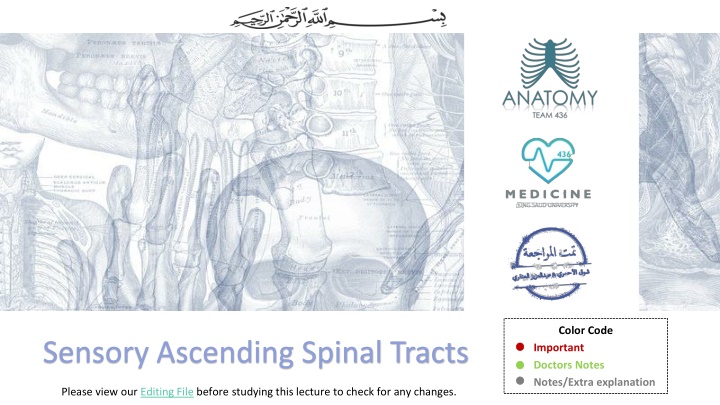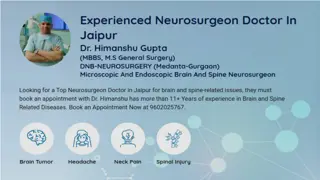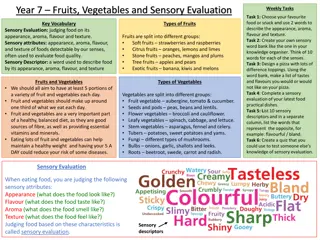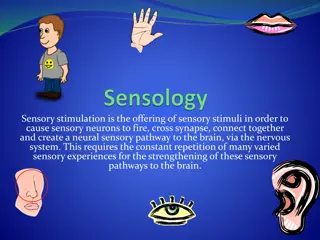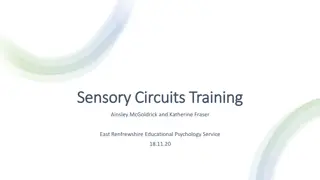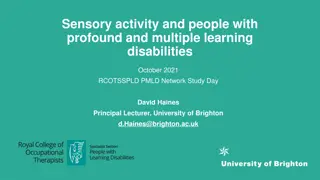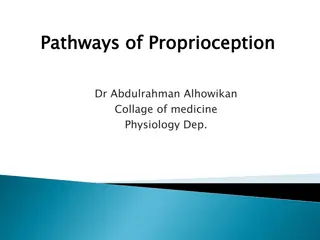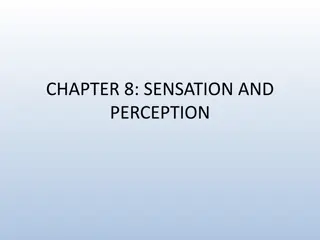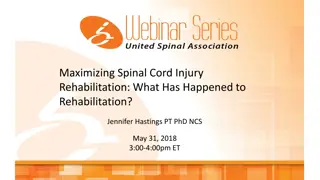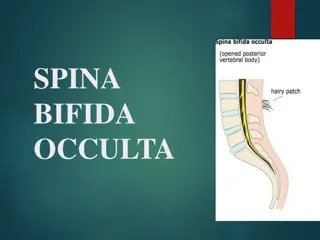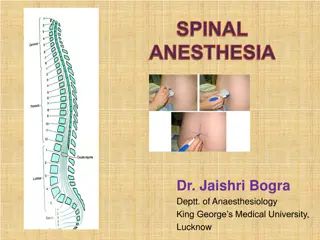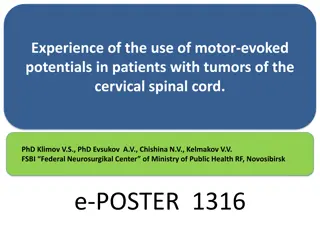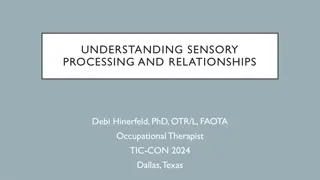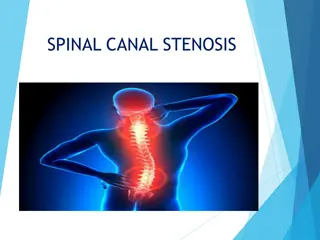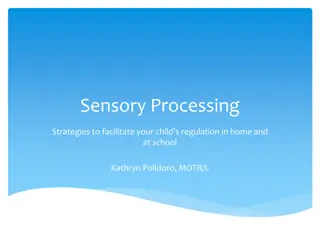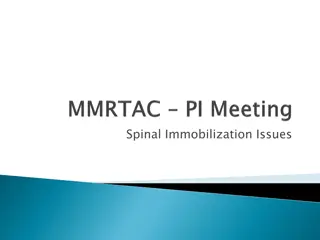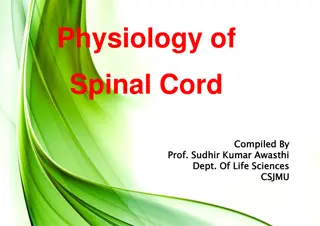Sensory Ascending Spinal Tracts
Learn about sensory ascending spinal tracts, their classification, functions, and pathways. Explore how information is carried to the brain at conscious and subconscious levels through different types of sensations. Gain insights into the organization of white matter tracts and their importance in sensory transmission.
Download Presentation

Please find below an Image/Link to download the presentation.
The content on the website is provided AS IS for your information and personal use only. It may not be sold, licensed, or shared on other websites without obtaining consent from the author.If you encounter any issues during the download, it is possible that the publisher has removed the file from their server.
You are allowed to download the files provided on this website for personal or commercial use, subject to the condition that they are used lawfully. All files are the property of their respective owners.
The content on the website is provided AS IS for your information and personal use only. It may not be sold, licensed, or shared on other websites without obtaining consent from the author.
E N D
Presentation Transcript
Color Code Important Doctors Notes Notes/Extra explanation Sensory Ascending Spinal Tracts Please view our Editing File before studying this lecture to check for any changes.
Objectives By the end of the lecture, the student will be able to: Define the meaning of a tract. Distinguish between the different types of tracts. Locate the position of each tract. Describe the sensory pathway. Identify the different sensory spinal tracts and their functions. Identify the course of each of these tracts. Know some associated lesions regarding the main tracts.
o The grey matter of the spinal cord is completely surrounded by the white matter o The white matter of the spinal cord consists of Ascending and Descending Nerve Fibers. o It is divided into Dorsal, Lateral & Ventral Columns or Funiculi. o White matter tracts: bundles or fasciculi of fibers that occupy more or less definite positions in the white matter. o They have the same Origin, Termination and carry the same Function.
White matter tracts are classified into: 1. Short Tracts; intersegmental or propriospinal. o Fibers occupy narrow band immediately peripheral to the grey matter (fasciculus proprius). o They interconnect adjacent or distant spinal segments and permit intersegmental coordination. (they do not reach the brain) 2. Long Tracts; divided according to function into: (a) Ascending (sensory or afferent). (b) Descending (motor or efferent). They serve to join the brain to the spinal cord. Note: In this lecture we will only discuss the ascending tracts
Ascending Tracts; o Carry impulses from pain, thermal, tactile, muscle and joint receptors to the brain. o Some of this information eventually reaches a conscious level (at the cerebral cortex), o while some is destined for subconscious centers (e.g at the cerebellum). There are 2 types of sensation: 1. At the conscious level (which we feel): these sensations reach the cerebral cortex. 2. At the subconscious level (we can t identify): the sensations only reach the cerebellum.
Pathways that carry information to a conscious level share certain common characteristics: oThere is a sequence of Three Neurones between the peripheral receptors and the cerebral cortex. (for the information/signal to reach the brain it has to relay/synapse in 3 neurons) The main fiber remains on the ipsilateral side of the cord and terminates in synaptic contact with the second neurone which lies either in the spinal grey matter or in the medulla oblongata of the brain stem. The axon of the second order neurone crosses over (decussates) to the opposite side of the CNS and ascends to the thalamus, where it terminates. 2 The axons of the first-order neurone or primary afferent neurone) enters the spinal cord through the dorsal root of a spinal nerve and its cell body lies in the dorsal root ganglion. 1 o The third-order neurone has its cell body in the thalamus. 3 o Its axon passes to the somatosensory cortex of the parietal lobe of the cerebral hemisphere.
Three major* pathways carry sensory information: 1. Dorsal (Posterior) column (divided into Gracile & Cuneate fasciculi) 2. Anterolateral pathway (Spinothalamic) 3. Spinocerebellar pathway Carry conscious sensation therefore they will follow the same pathway we discussed in the previous slide Carries subconscious sensation. *We will also discuss 3 minor ways: spinotectal, spino-olivary, and spinoreticular.
1. Dorsal Column 1. Dorsal Column o Contains two tracts; Fasciculus Gracilis (FG) & Fasciculus Cuneatus (FC) o Carry impulses concerned with proprioception (movement and joint position) , discriminative touch from ipsilateral* side of the body. o Contain the axons of primary afferent neurons that have entered cord through dorsal roots of spinal nerves. o Gracilis and cuneate have the same function, and travel in the same pathway but receive fibers from different segments of the spinal cord: Fasciculus Gracilis contains fibers that are received at sacral, lumbar and lower thoracic levels, Fasciculus Cuneatus contains fibers that are received at upper thoracic and cervical levels. Which is medial/lateral? Cuneatus supplies the upper limbs which are lateral to the lower limbs therefore cuneatus is lateral and gracilis is medial Gracilis Ground (lower limb) Cuneatus Cervical (next to upper limb) Extra
1. Dorsal Column 1. Dorsal Column o The primary afferent neurons relayed to the 1st order neurons in the dorsal root ganglion. o Fibers of the first order neurons ascend without interruption where they terminate upon 2nd order neurons in nucleus gracilis and nucleus cuneatus (in the medulla). o The axons of the 2nd order neurons decussate in the medulla as internal arcuate fibers. and ascend through the brain stem as Medial Lemniscus. o The medial lemniscus terminates in the ventral posterior nucleus of the thalamus (3rd order neurons), which project to the somatosensory cortex (thalamocortical fibers)
Tabes Dorsalis Subacute Combined Degeneration of the spinal cord o A systemic disease results from B12 deficiency o It produces Sensory Ataxia o Lateral columns are also affected (combined) causing weak and spastic limbs o It is completely recovered by proper treatment with B12 . Multiple Sclerosis o A late manifestation of syphilitic infection on the CNS. o Affects the lumbosacral dorsal spinal roots and dorsal columns of the spinal cord. o Leads to loss of proprioception which is manifested by a high Step Page and unsteady gait (Sensory Ataxia). 11:15 o An immune disease affects specifically fasciculus Cuneatus of the cervical region. Leads to loss of proprioception in hands and fingers (Asteriognosis) 07:07
2. Spinothalamic 2. Spinothalamic (anterolateral) Tracts Tracts o The spinothalamic tracts contain axons of second-order neurones, the cell bodies of which lie in the contralateral* dorsal horn. o Located lateral and ventral to the ventral horn. o Carry impulses concerned with; pain and thermal sensations (Lateral tract) and Non- Discriminative touch (crude) and pressure (Anterior tract), from the contralateral side. o In brain stem, the two tracts constitute the Spinal Lemniscus (recall the medial lemniscus). o Information is sent to the primary sensory cortex on the opposite side of the body. *ipsilateral: on the same side of the body. contralateral: on the opposite side of the body.
2 2. Spinothalamic Tracts . Spinothalamic Tracts Lateral Spinothalamic Tract Anterior Spinothalamic Tract Carries pain & Temperature to thalamus and sensory area of the cerebral cortex. Carries crude touch (non discriminative) & pressure to thalamus and sensory cortex. Function Neurones: 3 Neurones Neurone I: Small cells in the dorsal root ganglia. Neurone I: Medium sized cells in the dorsal root ganglia. Neurone II: Cells of substantia gelatinosa of Rolandi in the posterior horn. Neurone II: Cells of main sensory nucleus or (nucleus proprius). Neurone III: Cells of (VP*) nucleus of the thalamus. Neurone III: Cells of VP* nucleus of thalamus. Fibers arising from Substantia Gelatinosa & Nucleus Proprius decussate in the Anterior White Commissar and ascend as Spinal Lemniscus *Ventral Posterior
2. Spinothalamic Tracts 2. Spinothalamic Tracts Lesions The ventral commissure is close to the central canal. So when the central canal enlarges it presses on the fibers passing through it. o It is selectively damaged in Syringomyelia o The central canal becomes enlarged forming a cavity compressing the adjacent nerve fibres o Fibres serving pain and temperature are damaged as they decussate in the ventral white commissure close to the central canal causing selective loss of pain and temperature in the upper limbs (dissociate sensory loss) o Light touch and proprioceptive sensations are retained. o Joints of the limbs become disorganized without discomfort (Charcot's joint). (the joint looks misshapen but does not cause pain)
3. Spinocerebellar Tracts 3. Spinocerebellar Tracts o The Spinocerebellar system consists of a sequence of only two neurons; Neurone I:Large cells of dorsal root ganglia. Neurone II: cells of the nucleus dorsalis; Clark's nucleus (column) . o Two tracts: Dorsal &Ventral o Located near the dorsolateral and ventrolateral surfaces of the cord o Contain axons of the second order neurons o Carry information derived from muscle spindles, Golgi tendon and tactile receptors to the cerebellum for the control of posture and coordination of movements. (it is responsible for subconscious sensations)
3 3. Spinocerebellar Tracts . Spinocerebellar Tracts Posterior (Dorsal) Spinocerebellar Tract Ventral (Anterior) Spinocerebellar Tract o Present only above level L3 o The cell bodies of 2nd order neuron lie in Clark s column o Axons of 2nd order neuron terminate ipsilaterally (uncrossed) in the cerebellar cortex by entering through the inferior cerebellar peduncle. o Posterior spinocerebellar tract convey sensory information to the same side of the cerebellum o The cell bodies of 2nd order neuron lie in base of the dorsal horn of the lumbosacral segments o Axons of 2nd order neuron cross to opposite side, ascend as far as the midbrain, and then make a sharp turn caudally (the fibers cross the midline for the second time) and enter the superior cerebellar peduncle to terminate in the cerebellar cortex o So Ventral spinocerebellar tract conveys sensory information to the same side of the cerebellum
3 3. Spinocerebellar Tracts . Spinocerebellar Tracts Lesions Friedrichs ataxia oAn inherited degenerated disease oAffecting the spinocerebellar tracts oLeading to incoordination of arms, intense tremor, wide base reeling gait ataxia oIt begins in child hood oWheelchair is bound by 20 years of age (ataxia = gait)
Spinotectal Spinotectal Tract Tract o Ascends in the anterolateral part, in close association with spinothalamic system. o Primary afferents reach dorsal horn through dorsal roots and terminate on 2nd order neurons o The cell bodies of 2nd order neuron lie in base of the dorsal horn. o Axons of 2nd order neuron cross to opposite side, and project to the periaquiductal gray matter and superior colliculus in the midbrain. o Involved in reflexive turning of the head and eyes toward a point of cutaneous stimulation. Spinotectal: the fibers travel from the spine (spino-) to a region in the midbrain called tectum (-tectal) Extra
Spino Spino- -olivary olivary Tract Tract o Indirect spinocerebellar pathway (spino-olivo-cerebellar) meaning it connects the spinal cord with the cerebellum but indirectly through the olivary nucleus o Impulses from the spinal cord are relayed to the cerebellum via inferior olivary nucleus. o Conveys sensory information to the cerebellum. o Fibers arise at all levels of the spinal cord. o Contribute to movement coordination associated primarily with balance.
Spinoreticular Spinoreticular Tract Tract o Originates in the dorsal horn, and ascend in the ventrolateral region of the cord o Contains uncrossed fibers that end in medullary reticular formation & both crossed & uncrossed fibers that terminate in pontine reticular formation, finally to the thalamus; that activate the cerebral cortex o Forms part of the ascending reticular activating system (waking up). o Involved in perception of dull aching (slow pain)
Summary Summary Special thanks to Jawaher Alkhayyal!
MCQs MCQs 1. Which of the following is a short white matter tract? A- fasciculus proprius B- fasciculus gracilis C- fasciculus cuneatus D- fasciculus thalamus Answer: A 5. Multiple sclerosis affects which tract? A- fasciculus proprius B- fasciculus gracilis C- fasciculus cuneatus D- fasciculus thalamus Answer: C 2. Pathways that carry information to a conscious level have: A- 1 order neurons B- 2 order neurons C- 3 order neurons D- 4 order neurons Answer: C 6. Spinothalamic tracts send information to primary sensory cortex on the _____ of the body : A- same side B- opposite side Answer: B 7. The posterior spinocerebellar tract passes through: A- superior cerebellar peduncle B- middle cerebellar peduncle C- inferior cerebellar peduncle Answer: C 3. The internal arcuate fibers ascend through the brain stem as: A- lateral lemniscus B- medial lemniscus C- spinal lemniscus D- dorsal lemniscus Answer: B 8. Which of the following is involved in the perception of dull aching pain? A- spinotectal tract B- spino-olivary tract C- spinoreticular tract Answer: C 4. Tabes dorsalis is a late manifestation of which infection? A- Meningitis B- Syphilis C- Syringomyelia Answer: B
Leaders: Nawaf AlKhudairy Jawaher Abanumy Members: Talal alhuqayl Abdulmohsen alghannam Feedback anatomyteam436@gmail.com References: 1- Girls & Boys Slides 2- Greys Anatomy for Students 3- TeachMeAnatomy.com @anatomy436 Anatomy Team
